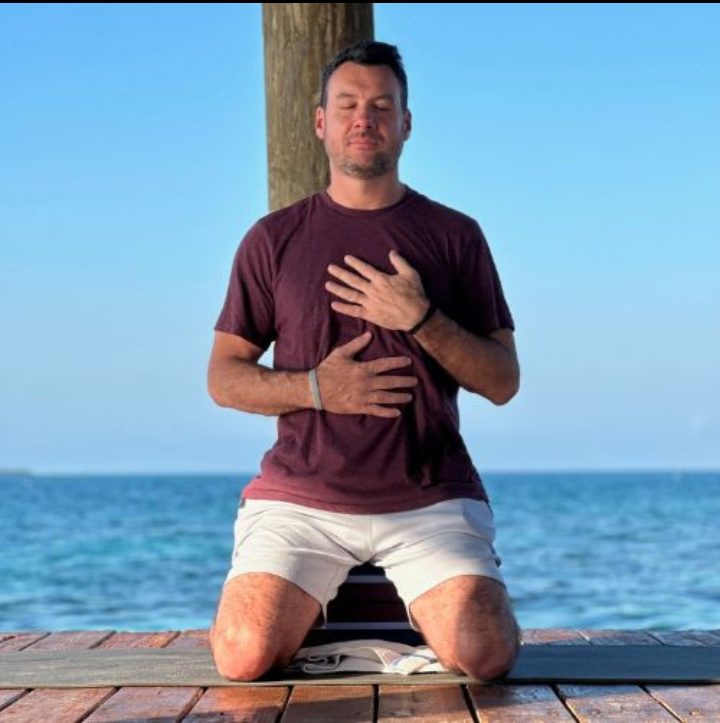TECH A BREAK:
PUT DOWN THE DEVICES AND RECHARGE
YOUR WELLBEING AND MENTAL HEALTH
In today’s deadline-driven and modern tech world, we all are doing our best to maintain busy lives, demanding careers and family expectations that can be stressful and hectic, but it is important to hold a space of quiet contemplation that allows your mind and body to settle into relaxation. To keep our mental and emotional health in check, practicing meditation on a regular basis comes with countless benefits to combat an increasingly chaotic world. According to the Mayo Clinic, meditation can wipe away the day’s stress, lower your heart rate and blood pressure, calm the nervous system and help manage your overall emotional and mental wellbeing.
Short History of Meditation
Meditation is an ancient practice that dates back thousands of years and has been part of various cultures and religions around the world. Its origins can be traced to the earliest recorded civilizations.
Prehistoric evidence suggests that early human beings practiced forms of meditation through rhythmic chants, repetitive movements, and focused breathing. These practices were likely connected to spiritual and shamanic rituals.
The oldest written records of meditation techniques come from ancient India, where meditation was an integral part of Hindu philosophical and religious traditions. The ancient Indian scriptures known as the Vedas, composed around 1500 BCE, contain references to meditation and its benefits.
Top Ten Basic Techniques for Your Own Meditation Practice
Diving into a meditation practice can be intimidating for beginners, but it doesn’t have to be. Here are top ten basic techniques to settle into your own practice.
- Find a comfortable place to settle into your practice. Set and setting are so important, especially for those just starting out. Set means your mindset . Setting is your environment. Starting meditation while anxious or agitated or in the middle of a loud, busy crowd, may not be the best place to start.
- Find a comfortable sitting position. The key word here is comfortable. You want your body to be in a place of ease, in order for your practice to be enjoyable and effective. This can mean sitting on a cushion cross legged or it can mean kneeling on the floor while resting on a cushion. If needed, you can always lay down or sit in a chair.
- Hand placement. Your hands can be rested on your knees or you can cradle one of your hands into the other and place them in your lap. You can also place one hand on the heart and the other on the belly. Or rest your hands wherever is comfortable and easeful.
- Sit with a tall spine. Keeping a straight spine allows energy to flow freely through the body and also helps you stay alert during the practice.
- Close your eyes or gaze softly down towards the ground. Closing your eyes helps create an environment free from visual distractions and helps you concentrate on your practice.
- Breathing. This is one of the most important parts of meditation. There are many reasons for this, one being that single pointed concentration on your breath gives your mind a place to focus.
- Relax your body. Holding tension in your body may keep you from being able to concentrate on your breathing. Allowing your body to relax also helps your mind to settle down so you can better concentrate on your meditation.
- No need to quiet the mind. This is one of the biggest misconceptions about meditation. As we all know, quieting the mind is next to impossible. You can, however, allow your thoughts to come and go without attachment to them.
- When your practice is completed, notice how your body feels. Compare this feeling with the feeling you had coming into the meditation.
- Go easy on yourself. Meditation is a practice that takes time to settle into. You may need time to try various techniques, postures, etc. Most importantly, enjoy the process.
While we all rely on technology and devices to keep our day-to-day lives moving, being mindful to take a meditative break and focus only on the present moment and self-awareness goes a long way to create a greater sense of peace, happiness and balance to put all of life’s challenges in perspective.
About Mike Williams
Mike Williams is the Co-Founder of The Direct Path Institute and Teacher specializing in Mindfulness and Meditation. The Direct Path Institute offers virtual and online yoga teacher training, meditation courses, therapeutic puppetry and play facilitator training as well as client retreats. For more information visit https://yourdirectpath.com/



































